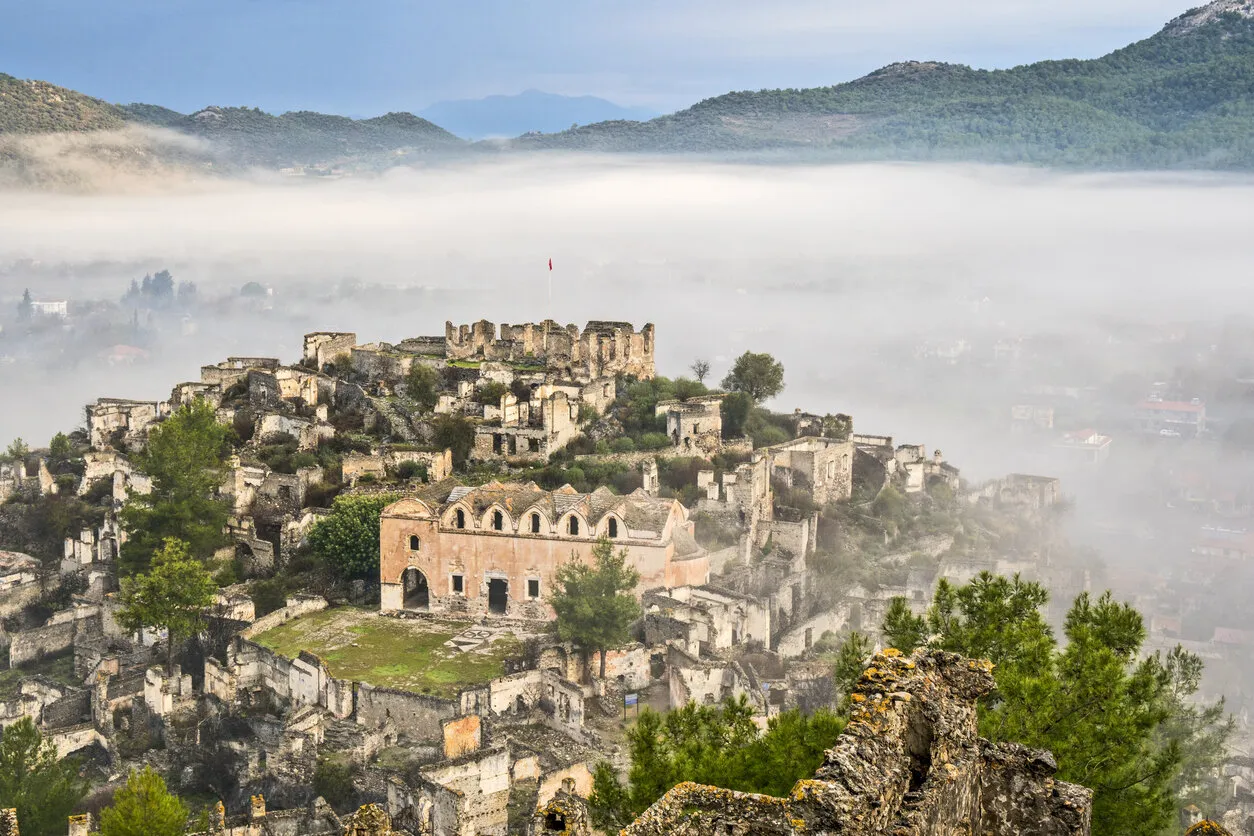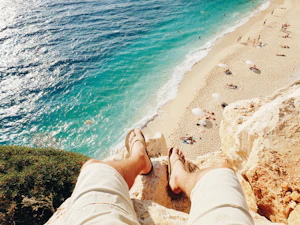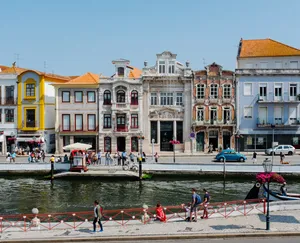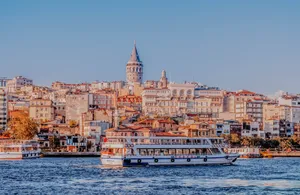Anatolia is a land that has been called home by countless civilizations, which have left their marks on this soil throughout the centuries. Every nook and corner of the country abounds in ancient sites and astounding historical landmarks. In the middle, central Anatolia takes us back to the ancient ages, ruled by the great Hittites, Lydians, and Phrygians. To the east of the country, there remains a remarkable range of intact ruins of Seljuk, Armenian, and Syriac heritage. To the north and northeast, the land boasts well-preserved remnants of the Ottoman and Pontic Greek eras. And finally, to the west, exquisite coastlines behold the finest examples of the ancient Roman and Greek sites.
Along this long-stretching coastline is where you’ll find the towns of Fethiye and Ölüdeniz in Mugla, two of the most beautiful tourist havens in all of Turkey. Known for their lush, picturesque nature and the abundant historical attractions that lay nestled within it, these two spots receive millions of tourists from various corners of the globe. While the list of major tourist attractions in this area is plentiful, for a moment, let’s take a look at a somewhat mysterious, hidden gem in the region, Kayaköy. While it has gained a little popularity in the last few years, it still remains mostly overshadowed by its more popular counterparts in the region.
Without further ado, let’s start our trip to the mysterious ghost town of Kayaköy.
Kayaköy
Known by the name of Karmylassos (Livissi, in modern Greek) in the ancient ages, Kayaköy’s earliest human activity dates to the 4th century BC. From the 11th century BC, the residents of Kayaköy primarily consisted of Christian Greeks.
During the Ottoman rule in the area, which lasted from the 14th to 20th centuries, the Christian Greek denizens of Kayaköy lived in peace with the Ottoman-Turkish rulers. However, following the Greco-Turkish War (1919-1922) in the first quarter of the 20th century and the signing of the Population Exchange Agreement between Greece and Turkey in 1923, the inhabitants of Kayaköy left for Greece, never to return. Most of the ruins that stand there today belonged to structures built in the 18th and 19th centuries. Still, ever since 1923, Kayaköy has been a ghost village where the disruptive elements of nature, such as earthquakes, wind, and humidity, are slowly turning the area into rubble.
Kayaköy was once a wealthy village that had mostly been occupied by the Ottoman Greeks. However, today it sits in ruin and rubble. The settlement was built on the slope of a hill nestled between lush mountains. The layout and the way the houses were lined up are unique and were purposefully done to ensure that one does not block the other’s view.
Before its abandonment, Kayaköy had a population of 3000, which is quite bustling for a village of such a size. The settlement was so active and lively that there was even a newspaper published regularly in Kayaköy.
What to See in Kayaköy
The site of Kayaköy comprises of more than 300 housings, many small chapels, 2 large churches, a school building, and a Customs Office.
The Streets of the Ghost Village
The narrow alleys with cobblestone paths that branch around the houses and churches like the roots of a plant are spectacular. It is fulfilling to walk along with the same paths that the old Greek residents of this village did over a century ago. It takes you back in time as you slowly explore the beautiful ruins these narrow, winding streets lead to and breathe in the air coated with mystery and sorrow.
The Lower Church (Panagia Pirgiotissa)
Panagia Pirgiotissa is undoubtedly the most well-preserved structure in Kayaköy. It presumed that the enormous size of the church was the prime reason behind it surviving until today. Footed gloriously in the center of the settlement, this church still has a few wall paintings and frescoes left. Moreover, the central hall and the entrance to the church have beautiful, intact pebble mosaics on the floor.
The atmosphere inside the church is breathtaking. It feels like the church gate is a portal that takes the visitors back to a time when Kayaköy was a thriving settlement.
The Upper Church (Taxiarchis)
Originally called Taxiarchis, the upper church had been used as a mosque after the abandonment of Kayaköy until 1960, which certainly slowed down its dilapidation. Like Panagia Pirgiotissa, its hall still beholds various well-preserved examples of pebble ceramics.
Atop Kayaköy
The peak of the hill on which the ruins are scattered offers a picturesque view of Kayaköy. But more than just a great idea, you’ll also find a small chapel resting comfortably at its peak. It a great spot to watch the sunset. I highly recommend that you hike up there in time for the sunset and sit by the chapel to take it in. This will surely help relieve your fatigue and add an unforgettable experience to your Kayaköy itinerary.
Af Kule Monastery Ruins
Although this spot is located 4.5 km to the west of Kayaköy, it is a must-see attraction. As the story goes, a monk named Ayios Elefterios built this monastery himself and spend his whole life there in agony. Among the locals in the area, this spot is known as Af Kule in Turkish, which literally translates as the “Tower of Forgiveness.” From Kayaköy, it takes approximately 45 minutes (one way) to hike to Af Kule. This place is situated right on the sea and, if you are blessed with clear weather, you will be fortunate enough to see the island of Rhodes in Greece clearly on the horizon.
Click here to access the route from Kayaköy to Af Kule on Google Maps.
Practical Information For Visitors
Working hours: Kayaköy can be visited every day from 10 am to 7 pm in the summer period (1 April-1 October), and from 8.30 am to 5.30 pm in the winter period (1 October-1 April). Please note that, due to the COVID-19 pandemic, the site opens to visitors at 11 am on the weekends.
Visiting fee: The ticket fee to see Kayaköy is 10 Turkish liras. For Museum Pass owners, it is free. Museum Pass Turkey allows free passage to all museums run by the Ministry of Culture and Tourism. So, instead of paying individually to visit all the museums (which would be more expensive in the long run), the Museum Pass is a more convenient and hassle-free solution to enjoy sightseeing. You can easily purchase one online or at the ticket booths of the ancient sites and museums. Click here to see the types of Museum Pass.
What you need to know before visiting: Make sure you wear shoes that are suitable for hiking on account of the rocky and upslope terrain of Kayaköy. Moreover, I suggest you bring plenty of water and snacks to keep up your energy during your trek. If your visit is during the summer, remember to bring along sunscreen as the sun gets scorching hot.
Where is Karaköy? How to get there?
Public Transportation
The most common issue about attractions like Kayaköy in Turkey is always the lack of convenient transportation or the road’s appalling condition leading up to these sites. However, in Kayaköy, such problems will not be encountered thanks to the minibusses that frequently go back and forth from Fethiye to Kayaköy. You can find an updated schedule below, starting from the 1st of November 2020.
From Fethiye to Kayaköy
07am/08am/09am/10am/11am/12pm/1pm/2pm/3pm/4pm/5pm/6.20pm
From Kayaköy to Fethiye
08am/09am/10am/11am/12pm/1pm/2pm/3pm/4pm/5pm/6pm/7pm
By a Personal Vehicle
Reaching Kayaköy by car is quite easy. If you use navigation, simply put Kayaköy as your destination, and you’ll have no problem getting there. If you are planning to stick to the road signboards, just follow the signboards that take you to Karmylassos (the ancient Greek name of Kayaköy), and it will all be fine.
The roads are asphalted and in good condition, which makes them comfortable to drive on. Parking at Kayaköy is free. Along the way to Kayaköy, you will be accompanied by long pine trees, rocky-green mountains that stretch along the Mediterranean Sea, and nature with jaw-dropping beauty.
Renting a Car (from Central Fethiye)
If you are planning on renting a car to go to Kayaköy, I would suggest you abstain from local dealers. It is a common problem for tourists to face cumbersome issues with their rental cars from local car shops.
It is always the safest bet to go with international and trustworthy chains. However, they may be more expensive in comparison with the local alternatives. You can always opt for Budget and Avis Rent a Cars in central Fethiye, where you can comfortably rent a vehicle.
Renting a Car (from Mugla Dalaman Airport)
At Muğla Dalaman Airport, there are many options to rent a car. You can access the websites of the car rental companies by clicking their names: Garenta, Sixt, Enterprise, Budget, Avis
With a Tour
There are some hotels and tour companies that arrange daily tours to Kayaköy. To get notified about the tours, you can consult your hotel staff or check the tour providers on Trip Advisor by clicking here.
What Else to See in the Area?
Here are some of the important sites around Kayaköy that you travel and history enthusiasts might not want to miss.
Amyntas King Grave
This 4th century BC Lycian grave can be found in downtown Fethiye. Thought to have been built for people of high status, the Amyntas King Grave is accessed by climbing a long set of stairs that consists of approximately 100 steps. The grave was named following the discovery of an ancient text that read “Amyntas, son of Herpamias” written in the 4th century BC Lycian language on the left column of the grave. Click to see the visiting hours and the ticket fee of the site.
The Ancient City of Telmessos & The Theatre of Telmessos
Telmessos was the largest city of Lycia (the ancient geographical region that covered southwest Anatolia, which includes the modern-day Turkish provinces of Antalya and Mugla). The ruins of the city are scattered all over the area that is now mainly Fethiye. Apart from the ancient rock-cut graves, the theatre of Telmessos, one of the closest-to-sea ancient theaters in the world, should not be missed.
Fethiye Archeology Museum
Fethiye Archeology Museum consists of two sections, which are the archeology and ethnography halls. Offering a unique collection of ancient Lycia, the museum beholds priceless findings, such as the Trilingual Epitaph (Lycian, Greek, and Syriac languages), Izraza Monument, votive offerings to Hero-God Kakasbos, and much more. The museum is free to visit. Click to see the visiting hours.
The Blue Lagoon of Ölüdeniz
Well-known as a haven for paraglider’s, Ölüdeniz is a very small town sandwiched between rocky and green hills. The Blue Lagoon of Ölüdeniz, offering one of the most beautiful color tones of water you will ever see on Turkey’s coastline, is a must-visit. Don’t forget your swimsuit!
The Butterfly Valley
Located to the south of the Blue Lagoon of Ölüdeniz, the Butterfly Valley is a stunning natural landmark that leaves you awestruck. It takes its name from the countless butterflies that call the valley home. With steep rocky hills that go as high up as 350 meters, the Butterfly Valley offers ineffable natural scenery.











Member discussion